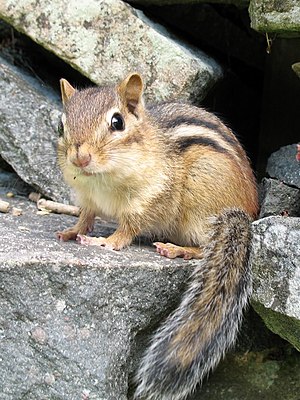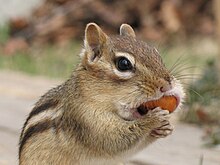Strip chipmunk
| Strip chipmunk | ||||||||||||
|---|---|---|---|---|---|---|---|---|---|---|---|---|

Strip chipmunk |
||||||||||||
| Systematics | ||||||||||||
|
||||||||||||
| Scientific name | ||||||||||||
| Tamias striatus | ||||||||||||
| ( Linnaeus , 1758) |
The striped chipmunk ( Tamias striatus ( Linnaeus , 1758)), also known as the eastern chipmunk and hackee , is a forest-dwelling rodent of the squirrel family (Sciuridae). Which occurs in eastern North America chipmunk is due to the lower relative to all other chipmunks number of upper front molars in its own subgenus Tamias ( Illiger , 1811), some authors in their own monotypic genus Tamias asked.
features
The striped chipmunk is a 13 to 19 cm large chipmunk . The length of the bushy tail is 7.5 to 11.5 cm. The animal is gray to black on the back and light brown on the belly. It owes its name to its black and white stripes on the side of the body and its large cheek pouches, which are used to transport its food.
distribution
This species is widespread in the deciduous forests on the east coast and in the hinterland of Canada and the United States .
Way of life
The maximum life expectancy of the diurnal striped chipmunk is around five years, but mostly only two to three years.
Its diet includes various tree fruits such as acorns, nuts, seeds, mushrooms and berries. These animals spend the night or their winter rest in self-dug underground structures. For the cold season, these squirrels put food supplies in hollow tree stumps and the like. Ä. on. These animals are true to their location and defend their territory (size: 0.08 to 0.60 ha) vigorously against other conspecifics. The main natural enemies include hawks , foxes , raccoons , weasels , snakes , bobcats , Canadian lynxes and domestic cats .
Reproduction
From mid-March to early April and mid-July to mid-August , after a gestation period of 31 days , the female gives birth to up to 15 young, usually 3 to 5, which are weaned after five weeks. Then they follow their mother for a few more months until they find their own territory.
Existence and threat, protection
The population of the species fluctuates greatly depending on the availability of food. This species is classified as Least Concern .
Internal system
Eleven subspecies are recognized:
- T. s. doorsiensis ( Wisconsin ): Similar to T. s. peninsulae with pale fur, but with a lighter and more noticeable spot behind the ears, dorsally grayer, the tail is more speckled with white.
- T. s. fisheri (lower reaches of the Hudson River , south to Virginia and east Kentucky , west to Ohio ): paler and grayer than type subspecies.
- T. s. griseus (west of the Great Sea, Upper Mississippi Valley): Larger and less pronounced coat pattern than the type subspecies, but grayer.
- T. s. lysteri ( New England , Upstate New York and southeastern Canada between Lake Huron and Nova Scotia )
- T. s. ohionensis (Ohio): Very dark and dull coat.
- T. s. peninsulae (Wisconsin and Michigan ): Medium in size, with very pale and copper colored fur.
- T. s. pipilans ( Louisiana ): Largest and most strongly colored subspecies with yellowish-brown colored cheeks and flanks.
- T. s. quebecensis ( Québec ): Similar to T. s. griseus , but smaller and darker, the white dorsal stripes ending in front of the base of the tail.
- T. s. rufescens (northwest Ohio , southern Michigans peninsula): Short tail and striking reddish markings.
- T. s. striatus (southern Ohio to Georgia )
- T. s. venustus (southwestern end of the occurrence, west of the Mississippi, south of Arkansas '): stripes on the back are lighter and more strongly colored, but shorter than on T. s. striatus.
literature
- Philip Withfield (ed.): The great world empire of the animals. 2000 mammals, birds, fish, reptiles and amphibians at a glance. Marshall, London 1992, ISBN 3-8247-8614-1 , pp. 160-161 (translation from English).
- Wilhelm owner (ed.), Erna Mohr: Encyclopedia of the animals. Volume 2, Weltbild, Augsburg 1991, ISBN 978-3-89350-361-2 , p. 429.
- Jiří Felix (ed.), Alena Čepická: America's fauna in color. Translated from the Czech by Jaroslav Konšal. Karl Müller Verlag, Erlangen 1989, pp. 198-199.
Web links
- Tamias striatus inthe IUCN 2012 Red List of Threatened Species . Posted by: Linzey, AV & NatureServe (Hammerson, G.), 2008. Retrieved 05/05/2013.
Individual evidence
- ^ Dana P. Snyder: Tamias striatus. In: Mammalian Species . No. 168, May 25, 1982, pp. 1–8, here p. 1, online (PDF; 1.03 MB) ( Memento of the original from October 29, 2013 in the Internet Archive ) Info: The archive link was automatically inserted and not yet checked. Please check the original and archive link according to the instructions and then remove this notice. .
- ^ Bernhard Grzimek : Grzimeks animal life. Encyclopedia of the Animal Kingdom. Volume 11: Mammals. Part 2. Edited by Irenäus Eibl-Eibesfeldt . Kindler, Zurich 1977, ISBN 3-463-16811-1 , p. 246.
- ^ After Dana P. Snyder: Tamias striatus. In: Mammalian Species. No. 168, May 25, 1982, p. 3.
- ^ Dana P. Snyder: Tamias striatus. In: Mammalian Species. No. 168, May 25, 1982, p. 3.
- ^ Dana P. Snyder: Tamias striatus. In: Mammalian Species. No. 168, May 25, 1982, p. 3.
- ^ Dana P. Snyder: Tamias striatus. In: Mammalian Species. No. 168, May 25, 1982, p. 3.

